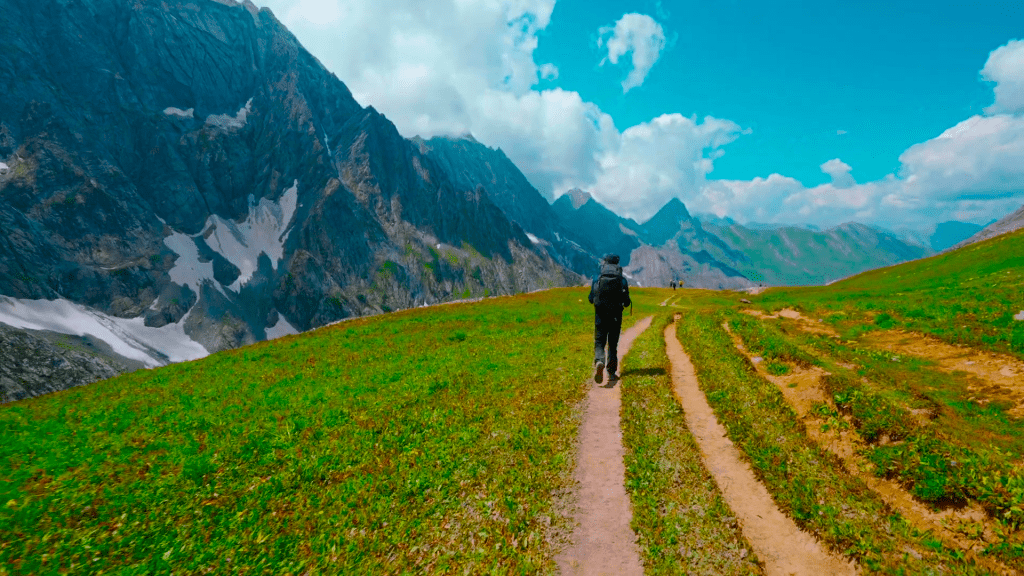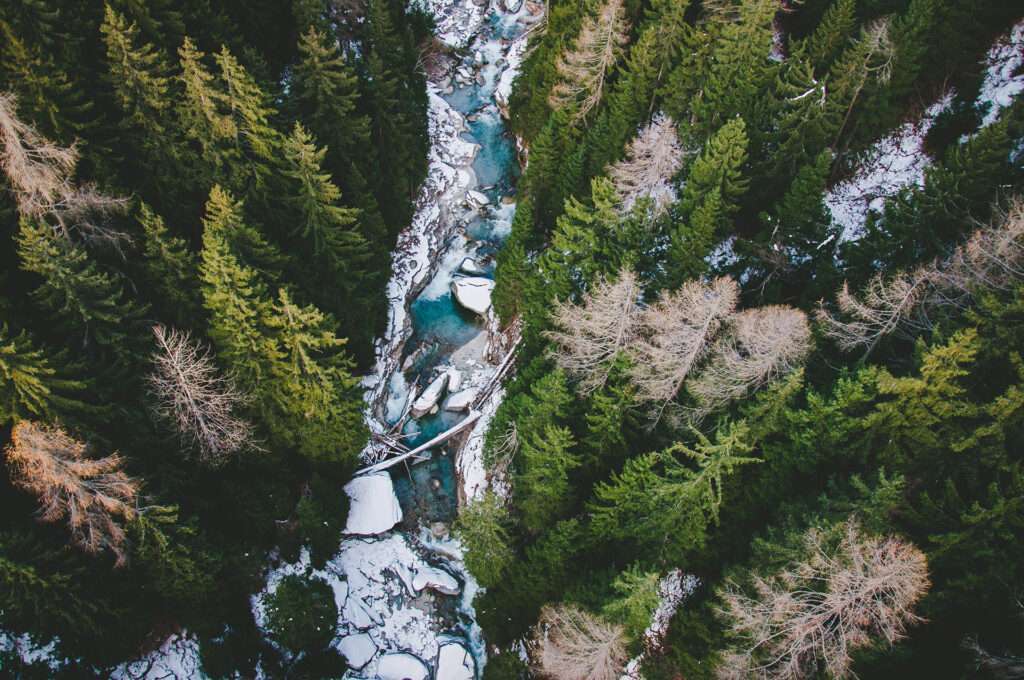Kounsarnag Lake Trek
Discover Kounsarnag Lake: Kashmir’s Alpine Glacial Adventure
The Kounsarnag Lake trek is one of Kashmir’s most picturesque and adventurous treks. Starting from the serene town of Aharbal, this trek offers a perfect blend of natural beauty, cultural experiences, and challenging terrains. As you ascend through dense forests, lush meadows, and rocky paths, you will be rewarded with stunning views of the Pir Panjal range. The highlight of the trek is reaching the pristine Kounsarnag Lake, a glacial lake situated at an altitude of 3,962 meters. This trek is ideal for those seeking a moderately challenging adventure, with opportunities to interact with local shepherds, spot Himalayan wildlife, and enjoy the tranquility of nature.
Highlights of the Kounsarnag Lake Trek:
- Scenic Beauty: Traverse through dense forests, lush meadows, and breathtaking landscapes.
- Kounsarnag Lake: The pristine glacial lake situated at an altitude of 3,962 meters.
- Varied Terrain: Experience diverse trekking conditions from dense forests to alpine meadows.
- Cultural Insights: Interact with local shepherds and experience the unique culture of Kashmir.
- Flora and Fauna: Spot a variety of Himalayan wildlife and exotic flora.
- Historical Significance: Explore the ancient routes used by Kashmiri shepherds and traders.
- Photographic Opportunities: Capture stunning panoramic views of the Pir Panjal range.
- Challenging yet Rewarding: Suitable for trekkers seeking a moderately challenging adventure.
- Isolation and Tranquility: Enjoy the solitude and peaceful environment away from urban chaos.
- Adventure and Exploration: Ideal for adventure enthusiasts and nature lovers.
Trek Details:
- Duration: 7 Days
- Difficulty Level: Moderate to Difficult
- Best Time to Visit: June to September
- Starting Point: Aharbal, Kashmir
- Ending Point: Kounsarnag Lake, Kashmir
The most affordable price
Scroll Down For Detailed Itinerary:
Detailed Itinerary:
Day 1: Arrival in Srinagar
- Starting Time: Upon arrival in Srinagar
- Activity: Transfer to Aharbal 64 km by road
- Description: Begin your adventure with a scenic drive from Srinagar to Aharbal, a gateway to Kashmir’s stunning treks. Nestled amidst pristine landscapes, Aharbal offers a serene starting point with its majestic waterfalls and lush greenery, perfect for nature lovers and adventure seekers alike. Overnight stay at a comfortable guesthouse or camp, immersing in the tranquility of Kashmir’s natural beauty.
Day 2: Aharbal to Kungwattan
- Starting Time: Early morning
- Trek Distance: 09 km
- Trek Duration: 5-6 hours
- Description: Embark on a picturesque trek from Aharbal to Kungwattan, traversing through dense pine forests and expansive meadows that showcase Kashmir’s rich biodiversity. The route offers stunning views of the Pir Panjal range, ideal for photographers and nature enthusiasts. Camp overnight under the starlit sky, rejuvenating amidst the peaceful ambiance of Kashmir’s wilderness.
Day 3: Kungwattan to Mahinag
- Starting Time: Early morning
- Trek Distance: 07 km
- Trek Duration: 5-6 hours
- Description: Continue your journey through enchanting meadows and verdant landscapes as you trek from Kungwattan to Mahinag. Encounter the diverse flora and fauna of the region, including rare Himalayan species, enhancing your trekking experience. Capture panoramic vistas of snow-capped peaks and pristine valleys, immersing yourself in the untouched beauty of Kashmir’s alpine terrain. Overnight stay amidst nature’s tranquility, cherishing the serenity of Mahinag.
Day 4: Mahinag to Kounsarnag Lake
- Starting Time: Early morning
- Trek Distance: 8 km
- Trek Duration: 6-7 hours
- Description: Challenge yourself with a rigorous ascent to Kounsarnag Lake, Kashmir’s largest alpine glacial lake nestled at an altitude of 3,962 meters. This exhilarating trek rewards with breathtaking views of the surrounding peaks and crystal-clear waters, perfect for adventure enthusiasts and photographers alike. Set up camp near the lake, surrounded by the majestic beauty of the Pir Panjal range, offering solitude and serenity amidst nature’s grandeur.
Day 5: Kounsarnag Lake Exploration and Acclimatization
- Starting Time: Not applicable (rest day)
- Trek Distance: Not applicable
- Trek Duration: Not applicable
- Description: Spend a day acclimatizing to the high altitude at Kounsarnag Lake, immersing yourself in its tranquil surroundings. Explore the shores of Kashmir’s largest alpine lake, renowned for its pristine beauty and spiritual significance. Engage in photography sessions capturing the essence of this remote wilderness, where peace and solitude prevail amidst the Himalayan peaks. Overnight stay by the lake, relishing the peaceful ambiance and natural splendor.
Day 6: Kounsarnag Lake to Kungwattan
- Starting Time: Early morning
- Trek Distance: 16 km
- Trek Duration: 8-9 hours
- Description: Begin your descent from Kounsarnag Lake to Kungwattan, retracing the scenic trail through lush meadows and dense forests. Marvel at the changing landscapes and vibrant flora, reflecting Kashmir’s rich biodiversity. This challenging trek downhill offers panoramic views of the valley below, promising unforgettable moments for trekkers seeking adventure and natural beauty. Camp overnight at Kungwattan, reminiscing about the journey through Kashmir’s pristine wilderness.
Day 7: Kungwattan to Aharbal and Departure
- Starting Time: Early morning
- Trek Distance: 09 km
- Trek Duration: 4-5 hours
- Description: Conclude your trek with a final stretch from Kungwattan to Aharbal, savoring the last moments amidst Kashmir’s natural splendor. Reflect on the unforgettable experiences and camaraderie forged during the adventure. Transfer back to Srinagar, bidding farewell to the picturesque landscapes and cultural richness of Kashmir. Depart with cherished memories of the Kounsarnag Lake trek, a journey that encapsulates the essence of adventure and exploration in the Himalayas.
Why Choose Us for Your Trekking Adventure:
- Experienced Guides: Our knowledgeable and friendly guides ensure a safe and enjoyable trekking experience.
- All-Inclusive Packages: From permits and camping gear to delicious meals and comfortable transport, we’ve got you covered.
- Sustainable Tourism: We prioritize eco-friendly practices to preserve the natural beauty of Kashmir.
Join us on the Kashmir Great Lakes Trek and create memories that will last a lifetime. Book your adventure today and discover the unparalleled splendor of Kashmir’s great outdoors.
Frequently Asked Questions (FAQs)
Q: What is the best time to visit Tarsar and Marsar Lakes? A: The best time to visit Tarsar and Marsar Lakes is from June to September. During these months, the weather is pleasant, the trails are clear, and the meadows are in full bloom, making it an ideal time for trekking.
Q: How difficult is the Tarsar Marsar trek? A: The Tarsar Marsar trek is considered moderate to difficult. It involves several steep ascents and descents, and trekkers need to be physically fit and prepared for high-altitude conditions.
Q: What kind of accommodation is available during the trek? A: Accommodation during the trek includes camping in tents at designated campsites such as Lidderwat, Shekwas, and Sundarsar. Trekkers need to carry their own camping gear or opt for organized treks that provide tents and other essentials.
Q: Are there any permits required for the trek? A: Yes, trekkers need to obtain permits from the Jammu and Kashmir Tourism Department. These permits are generally arranged by trekking agencies if you book through them.
Q: What should I pack for the Tarsar Marsar trek? A: Essential items include a good quality trekking backpack, sturdy trekking shoes, warm clothing, rain gear, sleeping bag, first-aid kit, water bottle, energy snacks, and personal toiletries. It’s also advisable to carry trekking poles and a camera.
Q: Is it safe to trek to Tarsar and Marsar Lakes? A: Yes, the trek is generally safe for tourists. However, it is recommended to trek with a guide or in a group, especially if you are not familiar with the terrain. Always check the local weather conditions and follow safety guidelines.
Q: Can beginners undertake the Tarsar Marsar trek? A: While the trek is not extremely technical, it does require a good level of fitness and some prior trekking experience. Beginners should prepare adequately and consider joining a guided trek to ensure safety and support.
Q: What is the altitude sickness risk on this trek? A: The trek reaches a maximum altitude of 13,000 feet at Marsar Lake. Trekkers may experience mild altitude sickness. It is important to acclimatize properly, stay hydrated, and ascend gradually to minimize risks.
Q: What kind of food is available during the trek? A: During the trek, food is typically simple and nutritious, consisting of items like rice, lentils, vegetables, chapatis, and tea. If you are on an organized trek, meals will be provided. Otherwise, you should carry your own provisions and cooking equipment.
Q: How can I prepare physically for the Tarsar Marsar trek? A: Physical preparation should include cardiovascular exercises such as running, cycling, and swimming to build endurance. Strength training for your legs, core, and upper body is also important. Additionally, practice hiking with a loaded backpack to simulate trekking conditions.
Q: Is it necessary to hire a guide for the Tarsar Marsar trek? A: While not mandatory, hiring a guide is highly recommended, especially for those unfamiliar with the terrain. Guides provide valuable knowledge about the trail, ensure safety, help with navigation, and enrich the trekking experience with local insights.
Q: What are the weather conditions like during the trek? A: The weather in the Kashmir Valley can be unpredictable. During the trekking season from June to September, days are generally pleasant with temperatures ranging from 15°C to 20°C, while nights can be cold, dropping to 0°C or lower. Rain and snow can occur, so it’s important to be prepared for varying conditions.
Additional Information:
- Weather: Be prepared for sudden weather changes. Pack warm clothes, even during the summer months.
- Connectivity: Mobile network coverage is limited along the trek. Inform your family and friends about the lack of connectivity.
- Eco-friendly Trekking: Carry all your waste back and avoid littering. Respect the local culture and natural environment.
- Hydration: Carry enough water and use purification tablets or a portable filter for drinking from natural sources.
- Wildlife and Flora: Keep an eye out for Himalayan wildlife. The region is also rich in diverse flora, including rare Himalayan flowers.
- Local Culture: Interact with local shepherds and villagers along the trekking route, gaining insights into their traditional way of life and culture.
- Emergency Contact: Carry emergency contact numbers of local authorities and your trekking agency for any unforeseen situations.






